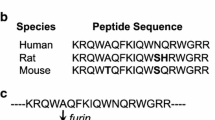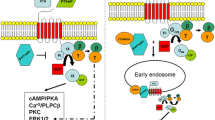Abstract
Amylin(1–8), a cyclic peptide consisting of the eight N-terminal amino acids of the 37-amino acid peptide amylin, has been shown to induce proliferation of primary osteoblasts and to induce bone formation in healthy male mice, whereas no data on efficacy in bone disease-related models have been reported. Therefore, we evaluated any effects of amylin(1–8) in ovariectomized rats with established osteopenia, a model for postmenopausal osteoporosis. At doses up to 100 nmol/kg/day, a dose highly effective in healthy mice, amylin(1–8) was unable to increase bone mineral density in ovariectomized rats during an 8-week treatment period. Histomorphometric analysis of the tibia indicated that amylin(1–8) did not change bone histomorphometric parameters. In an attempt to verify any potential biological effects of amylin(1–8), we investigated the efficacy of this peptide in various in vitro assays. Experiments designed to confirm previously published results on the proliferative effects of amylin(1–8) on primary osteoblasts failed to show any response. Amylin(1–8) was able to partially displace 125I-rat amylin(1–37) from amylin receptors composed of the calcitonin receptor and RAMP1, indicating specific interaction of the peptide with the amylin binding site. However, in vitro efficacy assays with amylin(1–8) in calcitonin receptor-RAMP-positive HEK293T and MCF7 cells failed to reveal any agonist activity of amylin(1–8), whereas amylin(1–37) showed the expected agonist activity. In conclusion, our results indicate that amylin(1–8) does not show agonist activity on amylin receptors, does not affect osteoblast proliferation, and is devoid of anabolic activity in bone.







Similar content being viewed by others
References
Alam AS, Moonga BS, Bevis PJ, Huang CL, Zaidi M (1993) Amylin inhibits bone resorption by a direct effect on the motility of rat osteoclasts. Exp Physiol 78:183–196
Christopoulos G, Perry KJ, Morfis M, Tilakaratne N, Gao Y, Fraser NJ, Main MJ, Foord SM, Sexton PM (1999) Multiple amylin receptors arise from receptor activity-modifying protein interaction with the calcitonin receptor gene product. Mol Pharmacol 56:235–242
Cornish J, Callon KE, Cooper GJ, Reid IR (1995) Amylin stimulates osteoblast proliferation and increases mineralized bone volume in adult mice. Biochem Biophys Res Commun 207:133–139
Cornish J, Callon KE, Lin CQ, Xiao CL, Mulvey TB, Coy DH, Cooper GJ, Reid IR (1998) Dissociation of the effects of amylin on osteoblast proliferation and bone resorption. Am J Physiol Endocrinol Metab 274:E827–E833
Cornish J, Callon KE, King AR, Cooper GJ, Reid IR (1998) Systemic administration of amylin increases bone mass, linear growth, and adiposity in adult male mice. Am J Physiol Endocrinol Metab 275:E694–E699
Cornish J, Callon KE, Lin CQ, Xiao CL, Mulvey TB, Cooper GJ, Reid IR (1999) Trifluoroacetate, a contaminant in purified proteins, inhibits proliferation of osteoblasts and chondrocytes. Am J Physiol Endocrinol Metab 277:E779–E783
Cornish J, Callon KE, Lin CQ, Xiao CL, Gamble GD, Cooper GJ, Reid IR (1999) Comparison of the effects of calcitonin gene-related peptide and amylin on osteoblasts. J Bone Miner Res 14:1302–1309
Cornish J, Callon KE, Gasser JA, Bava U, Gardiner EM, Coy DH, Cooper GJ, Reid IR (2000) Systemic administration of a novel octapeptide, amylin(1–8), increases bone volume in male mice. Am J Physiol Endocrinol Metab 279:E730–E735
Cornish J, Callon KE, Bava U, Kamona SA, Cooper GJ, Reid IR (2001) Effects of calcitonin, amylin, and calcitonin gene-related peptide on osteoclast development. Bone 29:162–168
Cornish J, Grey A, Callon KE, Naot D, Hill BL, Lin CQ, Balchin LM, Reid IR (2004) Shared pathways of osteoblast mitogenesis induced by amylin, adrenomedullin, and IGF-1. Biochem Biophys Res Commun 318:240–246
Dacquin R, Davey RA, Laplace C, Levasseur R, Morris HA, Goldring SR, Gebre-Medhin S, Galson DL, Zajac JD, Karsenty G (2004) Amylin inhibits bone resorption while the calcitonin receptor controls bone formation in vivo. J Cell Biol 164:509–514
Davey RA, Moore AJ, Chiu MW, Notini AJ, Morris HA, Zajac JD (2006) Effects of amylin deficiency on trabecular bone in young mice are sex-dependent. Calcif Tissue Int 78:398–403
Horcajada-Molteni MN, Davicco MJ, Lebecque P, Coxam V, Young AA, Barlet JP (2000) Amylin inhibits ovariectomy-induced bone loss in rats. J Endocrinol 165:663–668
Lee SK, Goldring SR, Lorenzo JA (1995) Expression of the calcitonin receptor in bone marrow cell cultures and in bone: a specific marker of the differentiated osteoclast that is regulated by calcitonin. Endocrinology 136:4572–4581
Muff R, Buhlmann N, Fischer JA, Born W (1999) An amylin receptor is revealed following co-transfection of a calcitonin receptor with receptor activity modifying proteins-1 or -3. Endocrinology 140:2924–2927
Nicholson GC, Moseley JM, Sexton PM, Mendelsohn FA, Martin TJ (1986) Abundant calcitonin receptors in isolated rat osteoclasts. Biochemical and autoradiographic characterization. J Clin Invest 78:355–360
Roh J, Chang CL, Bhalla A, Klein C, Hsu SY (2004) Intermedin is a calcitonin/calcitonin gene-related peptide family peptide acting through the calcitonin receptor-like receptor/receptor activity-modifying protein receptor complexes. J Biol Chem 279:7264–7274
Romero DF, Bryer HP, Rucinski B, Isserow JA, Buchinsky FJ, Cvetkovic M, Liu CC, Epstein S (1995) Amylin increases bone volume but cannot ameliorate diabetic osteopenia. Calcif Tissue Int 56:54–61
Rossowski WJ, Jiang NY, Coy DH (1997) Adrenomedullin, amylin, calcitonin gene-related peptide and their fragments are potent inhibitors of gastric acid secretion in rats. Eur J Pharmacol 336:51–63
Udawela M, Christopoulos G, Tilakaratne N, Christopoulos A, Albiston A, Sexton PM (2006) Distinct receptor activity-modifying protein domains differentially modulate interaction with calcitonin receptors. Mol Pharmacol 69:1984–1989
Villa I, Rubinacci A, Ravasi F, Ferrara AF, Guidobono F (1997) Effects of amylin on human osteoblast-like cells. Peptides 18:537–540
Villa I, Melzi R, Pagani F, Ravasi F, Rubinacci A, Guidobono F (2000) Effects of calcitonin gene-related peptide and amylin on human osteoblast-like cells proliferation. Eur J Pharmacol 409:273–278
Villa I, Dal Fiume C, Maestroni A, Rubinacci A, Ravasi F, Guidobono F (2003) Human osteoblast-like cell proliferation induced by calcitonin-related peptides involves PKC activity. Am J Physiol Endocrinol Metab 284:E627–E633
Wimalawansa SJ (1997) Amylin, calcitonin gene-related peptide, calcitonin, and adrenomedullin: a peptide superfamily. Crit Rev Neurobiol 11:167–239
Young A (2005) Amylin: physiology and pharmacoloy. Elsevier Academic Press, San Diego
Acknowledgments
We thank Karin Larsen, Christina Hansen, Claes Ekström, Jesper Rasmussen, Kennet Neist Christjansen, and Anne Qvist Rasmussen for expert technical assistance; Sritharan Shanmugam and Kirsten Ebbehøj for help with the measurements of dynamic light scattering; and Morten Karsdal for the measurement of cartilage markers.
Author information
Authors and Affiliations
Corresponding author
Additional information
M. T. Ramirez, M. Stahlhut, J. S. Petersen, R. Just, and C. Thorkildsen are or were employees of Zealand Pharma at the time this study was performed. J. S. Petersen has stock ownership in Zealand Pharma. M. Ellegaard received salary from Zealand Pharma as a temporary employee. N. R. Jørgensen, P. Schwarz, and S. Petersen have stated that they have no conflict of interest.
An erratum to this article can be found at http://dx.doi.org/10.1007/s00223-010-9342-7
Rights and permissions
About this article
Cite this article
Ellegaard, M., Thorkildsen, C., Petersen, S. et al. Amylin(1–8) is Devoid of Anabolic Activity in Bone. Calcif Tissue Int 86, 249–260 (2010). https://doi.org/10.1007/s00223-010-9338-3
Received:
Accepted:
Published:
Issue Date:
DOI: https://doi.org/10.1007/s00223-010-9338-3




